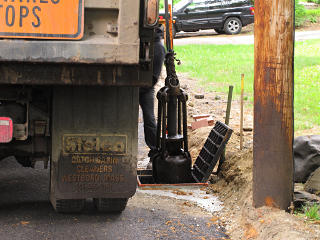
Anyway, they checked both basins and painted splotches of bright green on the grates before leaving.
[Thumbnail pictures are linked to larger ones.]
Water gone astray
|
During my travels in and out for the event prep I had noticed a wet area
near one of the catch basins while driving past. Since we'd gotten a few
rain sprinkles on some recent overnights I attributed it to that, failing
to take any specific note that the other grating was dead-dry. As there
didn't seem to be more work activity going on after that weekend, I decided
to head off and help someone with a little kitchen cabinetwork. The wet
area was *still* wet, so on the way out I stopped for a closer look and
discovered that there was a larger problem going on -- the puddle was
actually originating from about ten feet away from the catch basin, where
a little trickle of water was *bubbling out of the pavement*. Oops.
The sustained wetness was evidently from a water pipe leak somewhere
underneath. The catch basin on that side was already full right up to
the level of the pipe to the infiltration area, while the other one
was still empty.
Well, this would be a bit of a setback. It had clearly been going on at a low level for a couple of days, and if they weren't on it by now I figured they'd start fixing it some other morning soon and bopped off for my day of improving someone *else's* home for a change. In the middle of all that fun with tools I got a call from my neighbor. He and I had been sharing concerns about the brown water we'd been seeing from the taps and toilets recently, and the town utilities manager had been out to collect a couple of samples for lab analysis. Everyone attributed the discoloration to some normal backflush-pit maintenance work they'd been doing down at the pump-house rather than any of the road construction -- a little iron and manganese is perfectly normal and safe for the water around here, and sometimes certain cleaning operations temporarily kick the "rust" levels up a little. And after all, the water main work for the subdivision had been done months ago and there shouldn't have been any lingering effects from that. On the other hand they *had* done all that soil compaction more recently, however low a level they might have kept the roller at. Something in the interim, possibly coupled with minor pressure surges along the main from the pump-house activity, apparently loosened up enough to start leaking. The unregulated water pressure around here runs around 90 PSI with peaks over 100, nothing to sneeze at and connections have to be *tight*. That's why I got a regulator. Anyway, the neighbor said on the phone that someone was back doing work on the street and the water guys were wondering how to test if *I* still had water service since I didn't have an accessible external faucet at the time. Argh. The *one* goddamn day anybody was back to do work when I was off-site, assuming nobody was going to attack it that day. But apparently this had become enough of an emergency that the town guys were on it that afternoon. I encouraged said neighbor to go out and get some pictures of what they were doing. |
|
At this point I had a much better feel for how planning related to a
paving job goes. There's quite a lot of anticipation needed to accomodate
every possible feature that the asphalt layers will touch, and all of the
grading and crowning has to be correctly maintained throughout. They
had already pushed out a little beyond the originally intended edge,
but that was okay as for the most part they had leeway to do so up and
down the road and only had to work around some very minor obstacles.
Things again went quiet for several days, as once the binder layer was down and the various penetrations through it sorted out there wasn't any pressing need for the final phases of the job yet. Traffic came and went over what was there, much of it going entirely too fast [as expected, see above about "entitlement"] although calmed a little bit right at the low point by the cones still sitting on the drainage structures. And as we were still in pollen season a lot more of the organic crap fell freely onto the new surface. A notice showed up from the town public-works director one morning, warning that the final paving layer was really and truly going to happen on a specific date. The important message was for abutters to please plan ahead and avoid driving on it prematurely and/or wait several hours before venturing out and be really gentle while doing so, as tires turning too sharply would chew up the fresh surface. It seems that the vast majority of drivers in low-speed maneuvers crank their steering wheel around with the car sitting still, which simply grinds one spot on the tires against the pavement. There's no point to that unless you're stuck in a *really* tight parking spot; even there I will generally try to have just a little forward/back movement while swinging the wheel to make the tires actually *roll* while turning. |
The last chapter
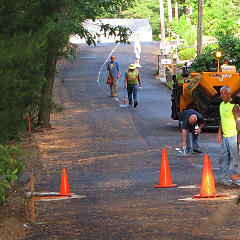
|
They started moving equipment and marking a nominal centerline for the paver to follow. Not position-critical, as they would just be matching the halves again. |
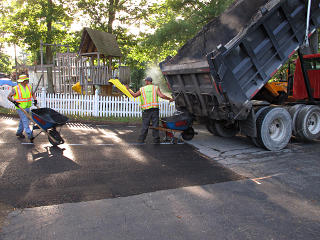
|
A smaller dump truck backed in at the head end where work would start. The cut between old and new is pretty obvious here; all this would be height-matched by the final layer. |
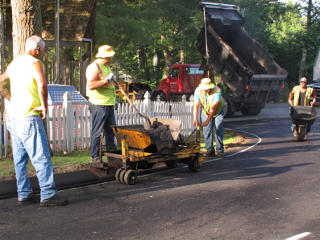
|
The truck was actually there to supply a specific mix for the
curb former instead of the main roadway. I hadn't seen one of
these in operation before, but after reading about how they work it
totally makes sense. This was the only spot where a conceptual "curb"
would be placed, if for nothing else than to keep drivers from cutting
the turn too close onto the abutter's strip of grass which he said
happens fairly frequently. See above about entitlement, inattention,
and bad driving.
What they couldn't do was *compact* the curb assembly, relying on the machine to extrude the mix under a little bit of pressure and then for it to just set in place. While hot, it was still fairly delicate. |
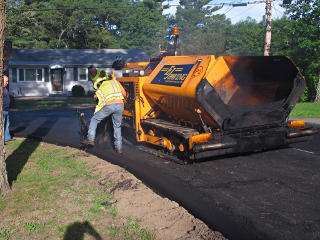
|
This meant as they started the main paving run, the guys had to be really careful to not step on the curb part while tending the machine. This led to some amusing hopping around. |
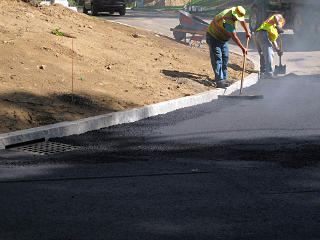
|
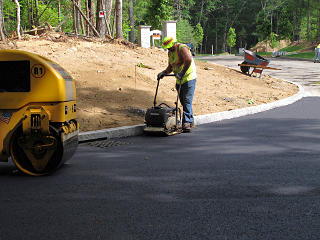
|
| Final trimming of the joint was by hand, and the Bouncy Thing could compact it right up to the curb without risking any scrapes by passing rollers. | |
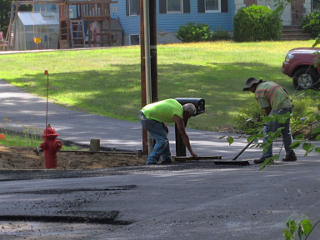
|
Final grades into the catch basins were level-checked along various axes as they finished up the rest of the intersection. |